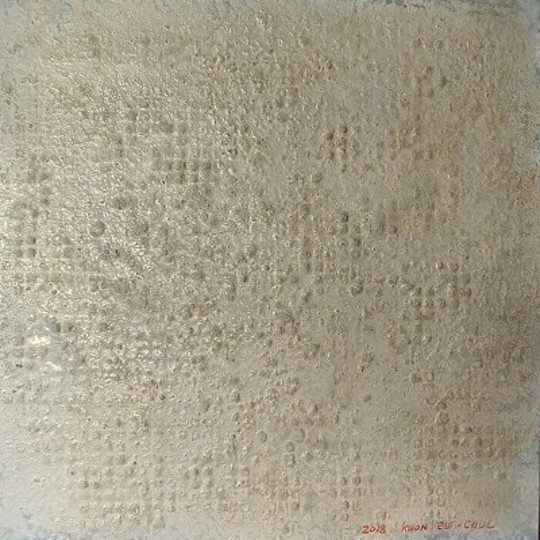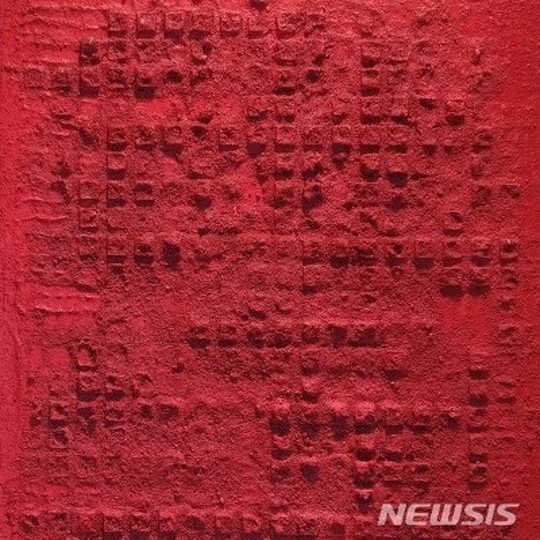박명인
권의철(權義鐵)의 단색화(Dansaekhwa)
expression of historic thought(意象) by modern paintings
- Understanding of trace shape by conscious emotion called imagination(像象) -
Park, Myeon-in(朴 明 仁: (Art critic and representative of the Korea Aesthetics Institute)
- 1Painters lack a sense of their individuality when they try to express objects’ necessity. They should understand objects’ circumstances(情狀) sensorially and express the internal and external characteristics by their thought(意想). Especially, ink stick’s characteristics are absolutely emphasized in Korean paintings(Oriental paintings). However, Kwon, Eui-chul uses the very small quantity of ink stick as a different point. And he uses acrylic with special materials like wood or woodrock foam boards. These malerisch act is thought to be intended to expand the malerisch field in a broad sense beyond genres of Korean paintings and Oriental paintings.
Kwon, Eui-chul modernizes his paintings escaping from limited materials and drawing culture and artistry from ancient civilization. And he understands objects by numerical shape(數象) which symbolizes time, inner shape that symbolizes ways, quality, or bases(根本) of things, and appearance(外象) as their results and creates his own symbols. For instance, When he watches a piece of wood, he understands it thinking of many things like what kind of wood this is(appearance:外象), how old it is(numerical shape:數象), whether he can define this as a piece of wood(linguistic shape:言象), and what it means(ideaistic shape:意象).
In addition, according to oriental painting theory, there are spirit(氣) and shapes(勢) in objects if they have forms(象). Of course, there are spirit(氣) and shapes(勢) even in Western art. It’s because they are vitality. Applying this theory to Kwon, Eui-chul’s paintings, Spirit can be the fronts(historicity) which express intaglio and relief on planes of monochromes based on white and shapes can be the images(modernity) that estimate and embody ancients’ thought(意想) included in the forms introduced from petroglyphs in his present works which seek 《History》 as a thesis. As mentioned above, History’s identity is to judge spirit and shapes understanding immanent meanings of the historic images by emotion including appearance,
- 1numerical shape, internal shape, linguistic shape, thought, and imagination.
Plane composition of the monochrome form is easy to say perspective’s negation physiologically. However, Kwon, Eui-chul’s meanings of paintings(畵意) are different from it. Immanent images like fonts or petroglyphs are expressed from relief complanation. Especially, external worlds are not disclosed and the relational structure of color plane is expanded to the expression area. And they can be general paintings which are filled with the painters’ meanings by harmony of modernity and them as historicity is pictorially actualized.
Especially, white is very much used. Someone says that white is colorlessness. However, white is a source of the colors with infinite mystery. Because of it, the fact that there are all colors in white should not be ignored. According to chromatology, the combination of optical colors is colorlessness and the combination of physical colors is black. Therefore, the state that the combination of colors is not is white in paintings. In conclusion, white and black are colors’ totality. Kwon, Eui-chul who applied this chooses how to add ink stick(black) in white, not adding white in ink stick.
This expressive tendency proved that the intention of Kwon, Eui-chul who majored in Korean paintings already escaped from Eastern and Western walls and reached malerisch stability. It’s because it is done with a chromatic characteristics and oriental ancient historical images motif and paintings make perfect by embodying it with modern techniques.
- 1Emphases of historicity which is metaphorically expressed in visual space include infinite areas, not limited image of yesterday and today as shown in the shapes. Change by time continuity is historic objects. All the objects which exist in nature go through the creation and destruction as their shapes are changed and physically damaged by weathering. However, because change of natural objects takes so long, time can be measured according to shapes. Therefore, the historic objects which can be observed from Kwon, Eui-chul’s work images make you feel the infinity of time. Temporality that forms of characters or objects of petroglyphs are metaphorically expressed is enough to analogize history of thousands of years. and when the historic images are compared with people in the past and modern men today, we find that they have basic ideal in common.
This thought as an artist is in collusion with the viewpoint of art history that ‘the 20th century’s culture and art burn with reversionary passion.’ The 20th century is the age that reversionary passion trace its several whereabouts throughout the entire fine art, art and though fields. Return means going back to the origin through characters. Theoretically, the way to return is like looking back on your youth and childhood after living half of your life. He tries to express reversionary thought by characters and cast new light on them by drawing the past circumstances by their record.
- 1For Kwon, Eui-chul’s character shapes, the letters which are summarized by the past stories through the reversionary concept like burning passion in the theory of culture and art in the 20th century. And he builds aesthetic experience in spirit and shapes of those forms to be his own pictorial field and mental thought(事象) causes several meanings by topicalizing sensual objects from historic ones as the meanings of the expression systems. In other words, it includes a wealth of polysemous meanings as creative symbolism and the polysemous characteristics get to emphasize powerful images as abstract paintings which harmonize with languages as they are drawn(現出) from symbolic thought.
Various set patterns analyzed from Kwon, Eui-chul’s works until now have found that the painter’s intention are integrated with the works’ shapes. Mostly, they are formed by understanding environmental ages or cultural properties based on aesthetic experience sensuously perceived by five senses(五感) and creativity is shown as intuition, enjoyment, and contemplation create special aspects(樣態). This can be defined as aesthetic categories in fine art. Kwon, Eui-chul’s pictoriality which seeks 《History》 constantly making it his works’ thesis forms aesthetic categories from historic trace including epitaphs or petroglyphs. So we can feel that the first observation(觀想) from the objects is change of nature and historic temporality through the epitaphs or petroglyphs. You can find Kwon, Eui-chul’s painting patterns which express temporality, culture, historicity, artistry beyond the concept of the past and present by drawing aesthetic icons with a creative motif.


